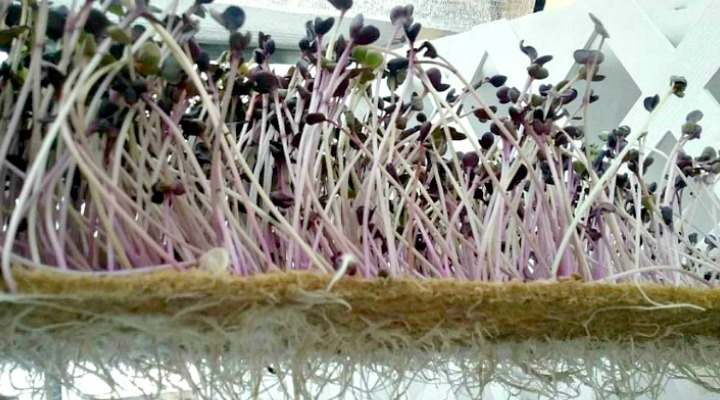
While “organic” refers to foods naturally grown in soil, we use nutrient-enhanced water and pH-neutral media as an optimal growing environment instead. We coined the term “ganix”, because our methods result in natural, high-quality food. Here’s what that means for you:
Material Conservation
We are happy to conserve soil, by not using it at all. A serendipity of this process is that we avoid soil-borne diseases and the constant time and expense of restoring soil after it is worn out. Most of our growing media is sanitized and reused, reducing waste. In the case of our microgreens, the growing media is biodegradable.
No Pesticides, Herbicides, or Harmful Chemicals
When necessary, tried-and-true organic recipes consisting of natural ingredients are misted onto our crops to handle infrequent pests in the greenhouse.

Food-Safe Equipment
We build all of our equipment using food-safe components. This includes our troughs and reservoirs, lined with BPA-free, FDA-approved material. We choose to use only approved food-safe reservoirs, flood tables, tubing, fittings, etc. Shelving is NSF listed, with many fittings pharmaceutical grade (an even higher rating than food safe).
Land Conservation
We need less space to grow plants, because we grow them vertically. Designed to deliver more produce per square foot, we make use of grow walls, trellising, towers, and multi-level racking systems.
Energy Conservation
Actually, half of the greenhouse is a built-in passive solar collector, sufficiently warming the air, and storing excess heat in the thick concrete floors and water reservoirs when the sun shines — even on the coldest winter days. When the sun is not shining, the thermal mass of the concrete floors and the water in the reservoirs help maintain an even temperature in the greenhouse as they radiate the stored warmth out into the growing spaces.
Heating
When the winter nights become extremely cold, we back up the radiant heating with an outdoor boiler. We use dead, downed, and discarded wood to fuel the boiler. Underground piping from the boiler to the greenhouse sends hot water through PEX tubing underneath the greenhouse to add more heat throughout the radiant concrete floor.
Cooling
We use natural cooling with strategically placed vents, shutters, and fans to help moderate the temperature. Retractable shade cloth panels help protect the plants from possible overheating. Our supplemental air handlers come on automatically when more extreme temperatures occur.

Lighting
Equipped with LED lights throughout, our building consumes far less electricity than the average facility. We use a new technology for plant growth. This provides a more efficient and natural approach to LED grow lighting utilizing the electromagnetic spectrum (EMS).
Re-purposed Materials
We use re-purposed steel, lumber, hardware, and furniture where practical. For instance, our greenhouse exterior includes steel siding left over from construction sites. Also left over from construction sites, insulated steel panels (that we’ve refinished to look like new) line the interior walls to separate climate zones. Some of our windows and doors come from lumber yards who had them on clearance due to slight aesthetic imperfections. We acquired other windows and doors on Craigslist. It doesn’t stop there. Our growing equipment includes scrap steel to construct our Kratky tables, supports, and racks. We used discarded dimensional lumber for troughs (subsequently lined with food-safe material) – all without sacrificing quality.

Want to read more about the plants we grow?
